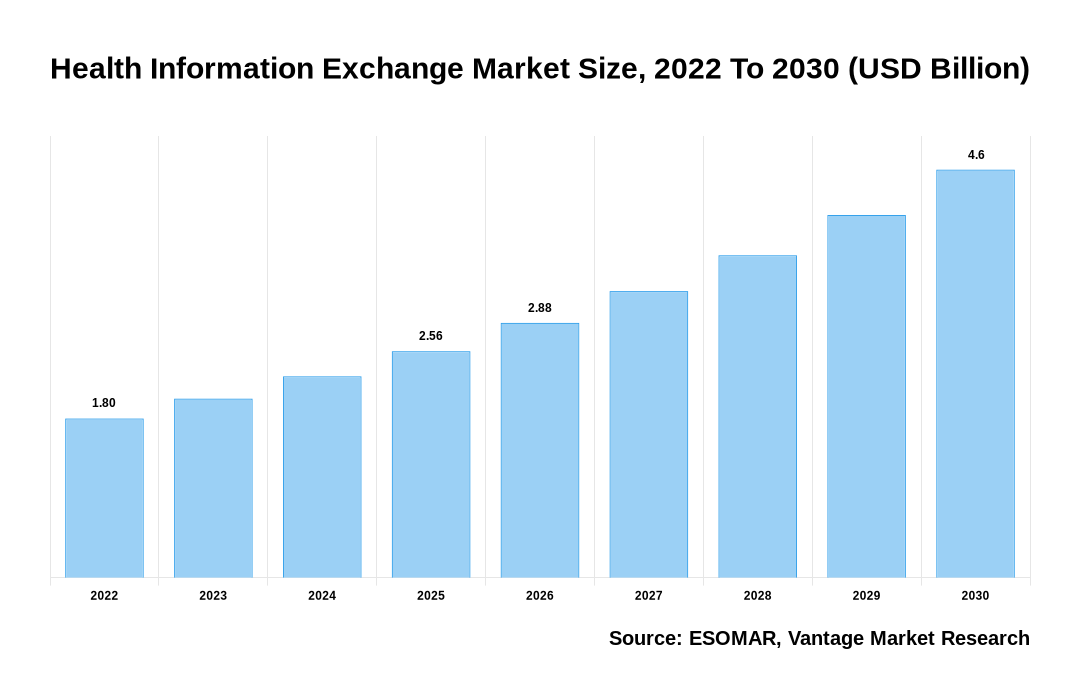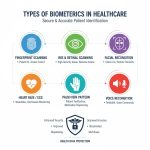Global Health Information Exchange Market
As stated in our extensive report, the Global Health Information Exchange Market accounted for USD 1.8 Billion in 2022 and is projected to reach a value of USD 4.6 Billion by 2030.
As healthcare organizations increasingly understand the importance and value of data exchange for better care coordination, cost savings, and improved patient outcomes, the market growth of the HIE sector is anticipated to continue in the years to come. The Health Information Exchange industry is primed for tremendous growth and will continue transforming healthcare data management thanks to continued technical improvements, helpful government efforts, and the increased focus on interoperability.
Technology developments are driving the Health Information Exchange market’s growth. Secure data storage, real-time analytics, and decision support systems are made possible by technologies like cloud computing, big data analytics, and artificial intelligence. These developments equip healthcare professionals with crucial information for individualized patient treatment, which produces superior results.
Government policies and regulations have significantly influenced the development of the Health Information Exchange market. Governments worldwide have put legislation and incentives in place to encourage the implementation of HIE because of its significance in enhancing healthcare delivery. The GDPR of the European Union and the HITECH Act in the United States have significantly accelerated the market’s expansion.
Click To Get a Free Sample On the Research Study

Key factors influencing Health Information Exchange Market Growth
The growth of the global Health Information Exchange market can be attributable to the following:
- Growing implementation of Electronic Health Records (EHR): One of the main factors driving the Health Information Exchange market is healthcare organizations’ increasing implementation of EHR systems. EHRs digitize patient records, allowing for safe retrieval, storage, and sharing among healthcare professionals. Health Information Exchange solutions are required to enable smooth data interchange between systems as more healthcare organizations switch to electronic records.
- Healthcare Interoperability: Healthcare interoperability is critical because it allows for the sharing and proper use of health information across various systems and organizations. Health Information Exchange is essential for establishing interoperability since it links multiple healthcare systems and allows patient data to be exchanged without interruption.
- Government Policies: Governments worldwide are implementing policies to encourage the adoption of Health Information Exchange These initiatives seek to raise the standard of treatment, ensure patient safety, and save costs. Healthcare providers are encouraged to engage in Health Information Exchange solutions by government incentives such as financial reimbursements and penalties linked to meaningful use of health information technology.
- Technological Developments: Technological development is a significant factor in expanding the Health Information Exchange Innovations like blockchain, artificial intelligence, and cloud computing have revolutionized how healthcare data is collected, processed, and shared. Scalability, flexibility, and cost-effectiveness are all features of cloud-based HIE solutions, while AI technology makes sophisticated analytics and decision assistance possible.
North America Region to Take Over the Market
The Health Information Exchange market is expected to be dominated by the North America region. The region, first and foremost, has a strong adoption rate for electronic health records (EHRs) and a well-established healthcare infrastructure.
Furthermore, government policies and actions that assist in implementing HIE systems are distinctive to North America. Initiatives like the HITECH Act, which offers financial incentives for the meaningful use of HIE technology, including Health Information Exchange, have been implemented, particularly in the United States.
North America is also home to several top vendors and service providers in the healthcare technology sector. The area can keep on the cutting edge of technological developments in the Health Information Exchange market because of these established players’ continued investments in research & development. The ongoing innovation and improvements in blockchain, AI, and cloud computing technologies further solidify North America ‘s position as the Health Information Exchange market’s industry leader.
Conclusion
Technology improvements, government initiatives, and the growing emphasis on interoperability and patient-centered care are driving the Health Information Exchange market, which is expected to grow significantly over the coming years. The need for Health Information Exchange solutions is anticipated to increase due to the expanding use of electronic health records (EHRs) and the requirement for seamless data interchange. Adopting cloud-based solutions, which provide scalability and enhanced analytics capabilities, distinguishes the market. Government rules and rewards encourage using Health Information Exchange systems even further while assuring data security, privacy, and interoperability standards. With its well-established healthcare infrastructure and promoting governmental initiatives, the North America area is well-positioned to dominate the industry. However, as healthcare systems develop and incorporate health IT solutions, the worldwide market offers growth potential in developing countries.
The well-known players of the Global Health Information Exchange Market include General Electric Healthcare (U.S.), Lightbeam (U.S.), Incite (U.S.), Data Trans Solutions (U.S.), Mediportal LLC (U.S.), Ciracet (U.S.), AXIOM Systems (U.S.), Arcadia.io (U.S.), Open Text Corporation (Canada), Infor (U.S.), Orion Health Group of Companies (U.S.) and others.
![[Market Research Reports] – Research Google News Blog | VMR.Biz](https://www.vmr.biz/wp-content/uploads/2022/12/logo-removebg-preview.png)











